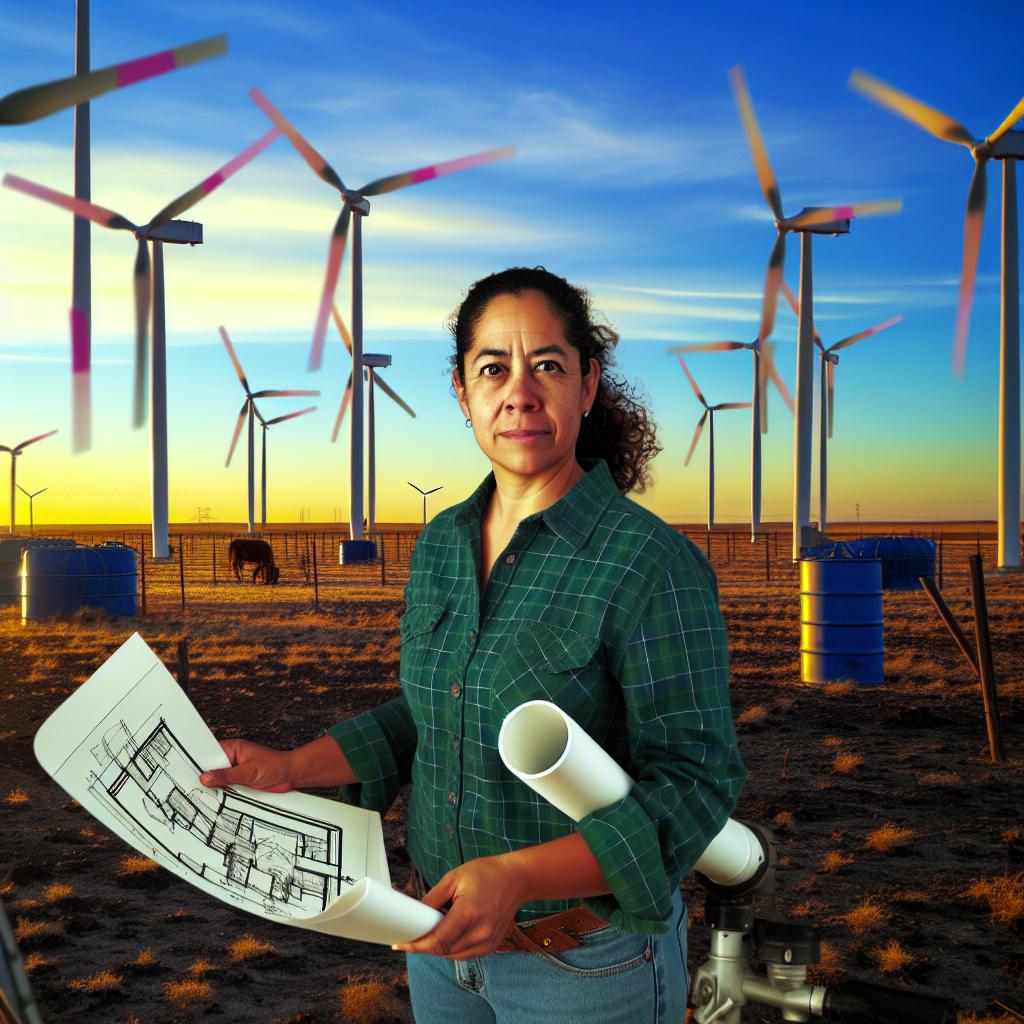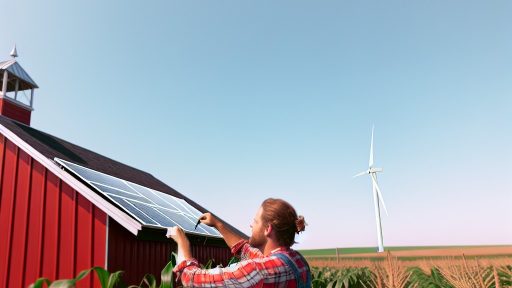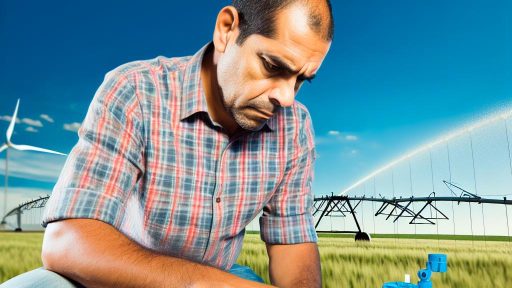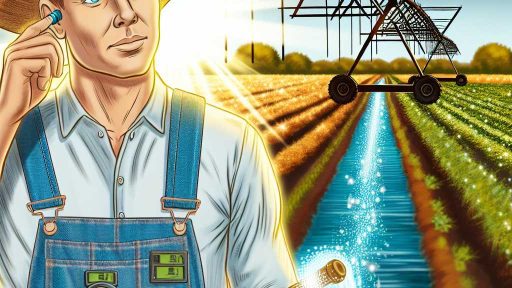Introduction to Wind-Driven Turbines and Their Relevance to Livestock Feed Production
Wind-driven turbines serve as a powerful solution for sustainable energy generation.
As fuel and energy costs rise, such technologies gain increased importance.
These turbines harness wind energy efficiently, providing a renewable resource.
Moreover, they can significantly lower operational costs in agricultural settings.
In the context of livestock feed production, wind energy plays a crucial role.
Benefits of Wind Energy for Agriculture
Wind energy offers numerous advantages for livestock feed production.
First, it reduces dependence on non-renewable energy sources.
This shift not only benefits farmers but also supports environmental sustainability.
Additionally, wind-driven turbines enable cost savings through reduced energy bills.
Farmers can then invest those savings into other areas of production.
Integration into Livestock Farming
Integrating wind-driven turbines into livestock farming further enhances sustainability.
These turbines can power feed mills, ensuring a consistent energy supply.
Furthermore, they can power irrigation systems for growing fresh feed.
This setup promotes self-sufficiency on farms, minimizing external resource needs.
Ultimately, it leads to a more resilient farming operation.
Transform Your Agribusiness
Unlock your farm's potential with expert advice tailored to your needs. Get actionable steps that drive real results.
Get StartedCase Studies and Real-World Applications
Several farms have successfully implemented wind-driven turbines.
For instance, Oak Hill Farm in Nebraska utilizes turbines for their feed processing.
They report a 30% reduction in energy costs after the installation.
Similarly, Green Fields Farm in Texas powers its milking parlor with wind energy.
These case studies highlight the ongoing shift toward sustainable practices.
Challenges and Considerations
Despite the benefits, challenges exist in implementing wind-driven turbines.
Initial installation costs can be high, deterring some farmers.
Additionally, site assessment is necessary to determine wind resource availability.
Lastly, maintenance of turbines requires technical knowledge and financial investment.
However, the long-term benefits often outweigh these challenges.
The Role of Renewable Energy in Sustainable Agriculture: A Focus on Wind Energy
Embracing Renewable Energy Sources
Renewable energy sources play a vital role in sustainable agriculture.
They help reduce greenhouse gas emissions significantly.
Farmers now embrace wind energy for various operational needs.
This shift encourages eco-friendly farming practices.
Benefits of Wind Energy in Agriculture
Wind energy provides numerous benefits for farming operations.
First, it reduces reliance on fossil fuels.
This leads to lower operational costs over time.
Moreover, it supports energy independence for farmers.
Consequently, wind turbines can generate electricity for farming equipment.
Integration of Wind-Driven Turbines
Integrating wind-driven turbines is crucial for sustainable livestock feed production.
First, these turbines provide a renewable energy source.
They can power feed mills and processing facilities.
In addition, they help maintain steady energy availability.
This ensures optimal performance in feed production processes.
Showcase Your Farming Business
Publish your professional farming services profile on our blog for a one-time fee of $200 and reach a dedicated audience of farmers and agribusiness owners.
Publish Your ProfileChallenges and Considerations
While wind energy is promising, it poses some challenges.
Initial installation costs can be high for farmers.
Additionally, geographic factors affect wind turbine efficiency.
Farmers must assess local wind conditions carefully.
Finally, navigating regulations is essential for successful implementation.
Future Prospects
The future of wind energy in agriculture looks promising.
Technological advancements may reduce costs further.
Innovations can enhance turbine efficiency and energy output.
As a result, more farmers may adopt this renewable energy source.
Ultimately, this shift supports sustainable and efficient livestock feed production.
Assessment of Wind Energy Potential in Livestock Farming Regions
Identifying Suitable Locations
To harness wind energy effectively, identifying suitable locations is crucial.
Wind energy potential varies significantly across different regions.
First, farmers should assess local wind patterns.
This information helps determine the best sites for turbine installation.
Additionally, topography influences wind speed and direction.
Flat areas often receive more consistent winds than hilly terrains.
Utilizing Wind Maps and Data
Wind maps provide valuable data for assessing energy potential.
These maps display average wind speeds over specified periods.
Farmers should consult local meteorological sources for accurate data.
Utilizing this data ensures informed decisions about turbine placement.
Evaluating Wind Speed and Frequency
Wind speed is a critical factor in turbine efficiency.
Higher wind speeds correlate with greater energy production.
Farmers should evaluate wind frequency as well.
A location with consistent wind patterns enhances reliability.
Wind energy systems benefit from sustained winds for optimal output.
Assessing Environmental Impact
Evaluating the environmental impact is essential for sustainable practices.
Wind turbines can affect local wildlife and ecosystems.
Farmers should conduct environmental assessments prior to installation.
This process includes reviewing potential effects on birds and bats.
A balanced approach ensures minimal disruption to nature.
Establishing Economic Viability
Financial considerations play a vital role in the decision-making process.
Farmers must evaluate the costs associated with turbine installation.
Potential revenue from energy savings can offset initial investment costs.
Grants and subsidies may be available to support installation.
Conducting a cost-benefit analysis helps determine feasibility.
Community Support and Engagement
Engaging with the local community fosters support for wind projects.
Conducting outreach can address concerns and gather feedback.
Informing neighbors about the benefits of wind energy is essential.
Community backing can facilitate smoother project implementation.
Find Out More: Understanding Animal Welfare Certifications For Humane Livestock Farming
Showcase Your Farming Business
Publish your professional farming services profile on our blog for a one-time fee of $200 and reach a dedicated audience of farmers and agribusiness owners.
Publish Your ProfileDesigning Wind-Driven Turbines for Efficient Energy Generation in Farms
Importance of Wind Energy in Agriculture
Wind energy offers a sustainable alternative for livestock feed production.
It reduces reliance on fossil fuels and minimizes greenhouse gas emissions.
Moreover, wind turbines can lower operational costs for farmers.
As a result, integrating wind energy benefits environmental sustainability.
Key Design Considerations for Wind Turbines
Designing effective wind turbines requires careful planning and research.
First, assess the average wind speed in the area.
This data helps determine the appropriate turbine size and type.
Next, consider turbine placement to maximize exposure to wind currents.
Additionally, select materials that withstand local weather conditions.
Types of Wind Turbines for Agriculture
Farmers can choose between horizontal and vertical axis wind turbines.
Horizontal axis turbines are popular due to their efficiency.
They typically generate more power at higher wind speeds.
On the other hand, vertical axis turbines require less maintenance.
They perform well in turbulent wind conditions, making them suitable for farms.
Integrating Wind Energy with Existing Systems
Wind-driven turbines can complement traditional farming practices.
By integrating turbines with existing energy systems, farmers increase versatility.
For example, farmers can pair wind turbines with solar panels.
This hybrid approach optimizes energy generation throughout the year.
Furthermore, energy storage solutions can enhance reliability and efficiency.
Assessing Economic Feasibility
Investing in wind-driven turbines requires a comprehensive economic analysis.
First, calculate the initial installation costs and ongoing maintenance expenses.
Consider potential savings from reduced energy bills over time.
Moreover, evaluate available government incentives or grants for renewable energy.
Finally, compare the long-term benefits with the initial investment.
Learn More: Implementing Traceability Protocols To Meet Stringent Organic Certification
Integration of Wind Energy Systems with Existing Livestock Feed Production Processes
Understanding Wind Energy Applications
Wind energy harnesses natural airflow to generate electricity.
This process is efficient and sustainable for various agricultural applications.
Utilizing wind turbines can significantly reduce dependency on fossil fuels.
Benefits of Integrating Wind Energy with Livestock Feed Production
Integrating wind energy can lower operational costs for feed production.
Additionally, it can enhance the sustainability of farming practices.
Wind energy systems can provide a reliable power source for feed mills.
Assessing Site Suitability for Wind Turbines
Site selection is crucial for maximizing wind energy generation.
Farmers should evaluate local wind patterns and environmental conditions.
Furthermore, proximity to feed production facilities matters significantly.
Modifying Existing Infrastructure
Adapting current feed production facilities can be beneficial.
Wind turbines can efficiently provide power for milling and processing equipment.
Moreover, systems can be designed for easy integration with existing structures.
Training and Knowledge Transfer
Training staff is essential to operate and maintain wind energy systems.
Partnerships with energy experts can enhance operational knowledge.
Sharing knowledge among farmers can foster successful implementations.
Showcase Your Farming Business
Publish your professional farming services profile on our blog for a one-time fee of $200 and reach a dedicated audience of farmers and agribusiness owners.
Publish Your ProfileMonitoring and Performance Evaluation
Regular monitoring of energy output is vital for system efficiency.
Farmers should establish benchmarks to assess performance over time.
Adjusting operations based on data ensures optimal energy use.
Delve into the Subject: Sustainable Livestock Production Methods for Climate-Resilient Farming
Economic Analysis
Cost-Benefit Evaluation of Implementing Wind Turbines in Livestock Farms
Implementing wind turbines in livestock farms offers various economic benefits.
First, these turbines reduce electricity costs significantly.
A farm like Green Meadow Acres experienced a 30% reduction in energy expenses.
Moreover, wind energy provides a stable energy source for operations.
This stability aids in budget planning over the long term.
Additionally, farmers can earn income by selling excess electricity.
For instance, Sunny Farm received quarterly payments from their local utility company.
Transitioning to renewable energy also attracts eco-conscious consumers.
Such consumers often pay a premium for sustainably-produced livestock products.
Initial Investment Considerations
The initial investment for wind turbines can be substantial.
Costs generally include equipment, installation, and maintenance.
A small-scale wind turbine can range from $30,000 to $50,000.
Additionally, farms must consider local regulations and permitting costs.
However, government incentives can offset some of these expenses.
Various subsidies and tax credits support renewable energy initiatives.
Farmers should conduct thorough research to identify available subsidies.
Long-Term Financial Benefits
Long-term savings from reduced electricity bills outweigh initial costs.
Moreover, these savings accumulate over time and enhance profitability.
For example, a farm investing in a wind turbine can recoup costs within ten years.
In addition, wind energy systems can increase property values.
Many buyers seek eco-friendly properties with renewable energy systems.
Thus, wind turbines can benefit farmers at the time of sale.
Sustainability and Economic Resilience
Wind energy contributes positively to environmental sustainability.
It reduces greenhouse gas emissions associated with traditional energy sources.
Moreover, sustainable practices improve farm resilience against climate change.
Farmers face fewer energy disruptions with their own energy source.
This resilience fosters long-term agricultural viability.
Moreover, adopting wind power aligns with global sustainability goals.
Thus, farmers play a role in preserving the environment for future generations.
Gain More Insights: Sustainable Farm Certification for Organic Crop and Livestock Production

Case Studies: Successful Implementations of Wind-Driven Turbines in Agricultural Settings
Innovative Practices in Denmark
Agricultural Innovation Denmark implemented wind turbines on livestock farms.
This initiative provided sustainable energy for feed production.
Farmers reported lower energy costs and increased profitability.
They also noticed improvements in the efficiency of feed production.
Effective Solutions in the United States
Sunny Acres Farm in California harnesses wind energy for their operations.
By installing wind-driven turbines, they significantly reduced their carbon footprint.
Showcase Your Farming Business
Publish your professional farming services profile on our blog for a one-time fee of $200 and reach a dedicated audience of farmers and agribusiness owners.
Publish Your ProfileThe farm produces high-quality feed while conserving natural resources.
Local farmers are now interested in adopting similar systems.
Successful Integration in Australia
Green Pastures Agronomy has capitalized on wind energy to power feed mills.
This integration has led to more sustainable livestock practices.
Farmers are experiencing enhanced productivity as a result.
Moreover, they have decreased dependency on fossil fuels.
Community Impact in Spain
A cooperative in Spain established community-owned wind turbines.
This project serves multiple farms and stabilizes energy costs.
Farmers benefit from shared resources and enhanced collaboration.
The community has improved its overall sustainability profile.
Lessons Learned from Various Regions
These case studies highlight the adaptability of wind-driven turbines.
Farmers must consider local wind patterns and regulatory frameworks.
Partnerships with experienced energy companies can facilitate success.
In each case, a clear plan for maintenance ensured longevity of the systems.
These successful implementations pave the way for future advancements in agriculture.
Challenges and Solutions in the Implementation of Wind Turbines for Feed Production
Understanding the Technical Challenges
Wind turbine technology can be complex to implement.
Farmers might lack the necessary technical expertise.
Additionally, maintenance requirements may overwhelm small-scale producers.
These issues can deter farmers from adopting wind energy solutions.
Financial Barriers to Entry
Initial costs for wind turbine installation often pose a significant barrier.
Many farmers face challenges securing financing for the investment.
Moreover, the return on investment can appear uncertain initially.
Spatial Limitations and Land Use Concerns
Wind turbines require substantial spatial allocation for installation.
Farmers may struggle to find suitable land that meets regulatory requirements.
Moreover, community opposition can arise over potential aesthetic impacts.
Solutions to Overcome Technical Challenges
Partnering with renewable energy experts can provide valuable guidance.
Farmers should seek training programs to enhance their technical skills.
Additionally, investing in user-friendly technology can simplify operations.
Strategies to Address Financial Concerns
Exploring government grants and subsidies can ease financial pressures.
Farmers can collaborate with cooperatives to share installation costs.
Furthermore, long-term financing options can help spread costs over time.
Mitigating Spatial and Community Issues
Conducting community outreach can foster support for projects.
Educating neighbors about wind energy benefits may alleviate concerns.
Moreover, site assessments can identify less intrusive locations for turbines.
Future Innovations in Wind Energy
Advancements in turbine efficiency can enhance viability and sustainability.
Smaller, more adaptable turbines may better suit diverse farm settings.
Additionally, integrating wind energy with existing agricultural practices can maximize benefits.
Future Trends: Innovations in Wind Energy Technologies for Sustainable Agriculture
Emerging Wind Technologies
New wind technologies are revolutionizing sustainable agriculture.
These innovations enhance efficiency and reduce costs.
Innovative turbine designs are optimized for agricultural settings.
Showcase Your Farming Business
Publish your professional farming services profile on our blog for a one-time fee of $200 and reach a dedicated audience of farmers and agribusiness owners.
Publish Your ProfileVertical axis wind turbines are gaining popularity for small farms.
They offer unique advantages, including lower height and easier maintenance.
Integration with Other Renewable Energy Sources
Farmers are increasingly integrating wind energy with solar power.
This hybrid approach maximizes energy generation potential.
Combining resources increases overall efficiency and reliability.
Furthermore, it diversifies the energy portfolio of agricultural operations.
Smart Technology and Automation
Smart technologies are enhancing the functionality of wind-driven turbines.
IoT-enabled systems monitor and optimize energy production.
Automated controls adjust turbine angles to maximize wind capture.
Data analytics improve decision-making for energy management.
Financial Incentives and Policy Support
Government incentives are encouraging wind energy adoption in agriculture.
Subsidies and grants help offset initial investment costs.
Supportive policies promote research and development in wind technologies.
Farmers are taking advantage of these financial tools to adopt innovation.
Environmental Benefits
Using wind energy reduces the carbon footprint of livestock feed production.
It minimizes reliance on fossil fuels and enhances sustainability.
Additionally, wind energy preserves water resources, critical for agriculture.
Wind-driven systems have a lower environmental impact than traditional methods.
Community and Economic Impact
Developing wind energy projects can boost local economies.
They create jobs during both installation and maintenance phases.
Community ownership models encourage shared benefits and engagement.
Consequently, rural areas experience improved economic vitality.
Additional Resources
A comprehensive review on smart and sustainable agriculture using …




